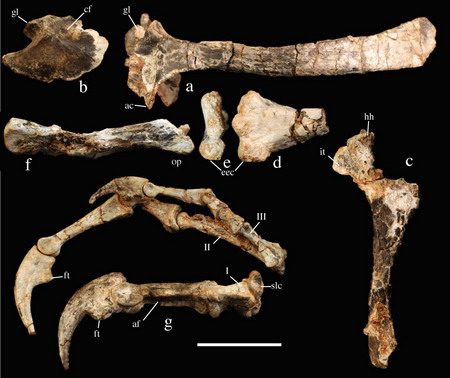Society
China unearthed oldest known ancestor of birds
(Agencies)
Updated: 2010-01-29 04:36
 |
Large Medium Small |
|
 An image showing the fossil bones of a newly discovered carnivorous dinosaur called "Haplocheirus sollers" is released by the Chinese Academy of Sciences on January 28, 2010. China has unearthed the fossil of a two-legged carnivorous dinosaur that lived 160 million years ago and which researchers have identified as the earliest known member of a long lineage than includes birds. [Agencies] |
|
 The skeleton of the newly discovered fossil of a carnivorous dinosaur called "Haplocheirus sollers" is seen at a Chinese Academy of Sciences' workshop on the outskirts of Beijing, January 26, 2010. China has unearthed the fossil of a two-legged carnivorous dinosaur that lived 160 million years ago and which researchers have identified as the earliest known member of a long lineage than includes birds. Picture taken January 26, 2010. [Agencies] |
HONG KONG: China has unearthed the fossil of a two-legged carnivorous dinosaur that lived 160 million years ago and which researchers have identified as the earliest known member of a long lineage than includes birds.
The "Haplocheirus sollers" had a long, narrow skull, many small teeth and powerful biceps and forelimbs, which enabled it to hunt primitive lizards, small mammals and reptiles, the experts wrote in the latest issue of the journal Science.
The individual, believed to be a young adult when it died, had a long tail and a total body length of between 190 and 230 cm. (6 feet 2 inches to 7 feet 6 inches). It was found in orange mudstone beds in the Junggar Basin in China's far western Xinjiang region.
"Their legs have four digits like modern birds, with three digits pointing forwards. The first digit, unlike in birds which point backwards, this one points sideways," he said.
Xu, a member on a research team led by Jonah Choiniere at the George Washington University in Washington, said that while this species shared some features with birds, it was more like a "typical carnivorous dinosaur".
"The most salient feature of this group is their forelimbs, they are predators. They have three claws on their hands, used to catch other animals. They have very bizarre forelimbs, they are very short but very stout and very strong," said Xu.
"Primitive lizards, small mammals, mammal-like reptiles were all possible food items," he told Reuters by telephone.
"They represent the earlier stage in the evolution of birds, but they are not birds. You can say they are early ancestors of birds ... and very slowly, it (the lineage) turned into birds."
This species belongs to the family of Alvarezsauridae - a bizarre group of bird-like dinosaurs - and its discovery pushes the fossil record of this family back by 60 million years into the Late Jurassic period (145 million to 199 million years ago).
The Haplocheirus is about 60 million years older than the next oldest known Alvarezsauroid, which was discovered in Argentina in 1991 and lived 95 million years ago during the Cretaceous period (65 million to 145 million years ago).
"We know birds are derived from dinosaurs. But most of our original fossils are from the Cretaceous period. Now we hope to find more Jurassic fossils. This way we can find more direct evidence to prove that birds evolved from dinosaurs," said Xu.












